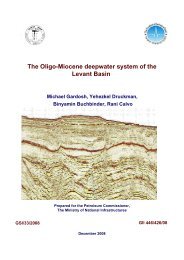tivity on the carmel faul
tivity on the carmel faul
tivity on the carmel faul
Create successful ePaper yourself
Turn your PDF publications into a flip-book with our unique Google optimized e-Paper software.
The first step in establishing viability is <strong>the</strong> exclusi<strong>on</strong> of all o<strong>the</strong>r n<strong>on</strong>-seismic causes for<br />
damage in Denya Cave. Becker et al. (2006) compiled all n<strong>on</strong>-seismic alternative causes for<br />
damage, which needed to be refuted for Denya Cave:<br />
1. Anthropogenic sources—recent damage by c<strong>on</strong>structi<strong>on</strong> of <strong>the</strong> Denya neighborhood<br />
can be distinguished from less recent seismic events by morphological assessment<br />
(Crispim, 1999) and dating. Initial results indicate that ages of damage are within <strong>the</strong><br />
range of thousands of years or more. Human and animal ac<str<strong>on</strong>g>tivity</str<strong>on</strong>g> in <strong>the</strong> cave is ruled<br />
out as sources of damage since <strong>the</strong> cave was closed to <strong>the</strong> surface until its artificial<br />
opening in <strong>the</strong> twentieth century CE.<br />
2. Underground glaciers and ice creep or frost acti<strong>on</strong>—in this part of <strong>the</strong> Levant cave<br />
temperatures were significantly above freezing during <strong>the</strong> period investigated<br />
(Frumkin et al., 1999; Bar-Mat<strong>the</strong>ws et al., 2000; Ayal<strong>on</strong> et al., 2002).<br />
3. Erosi<strong>on</strong> and soil creep—water circulati<strong>on</strong> in <strong>the</strong> cave seems to be of a very low<br />
energy and no areas of <strong>the</strong> cave seem to have sediment fills that show any signs of<br />
creep.<br />
4. Flood and debris flow—as well as a lack of evidence of sediment fills, <strong>the</strong> overall<br />
structure of <strong>the</strong> cave does not seem to show any signs of flooding. Fur<strong>the</strong>rmore, <strong>the</strong>re<br />
doesn’t seem to be any c<strong>on</strong>venient water source that could cause a major flood in <strong>the</strong><br />
area or any aperture whereby a large amount of water could enter and/or exit <strong>the</strong> cave.<br />
5. Incati<strong>on</strong>s (cave instability that may result in rock fall or <strong>the</strong> collapse of whole cave<br />
secti<strong>on</strong>s)—<strong>the</strong>se occurrences may well be <strong>the</strong> result of earthquakes, but might also be<br />
due to gravitati<strong>on</strong>al effects caused by <strong>the</strong> instability of crevasses or <strong>the</strong> overall<br />
c<strong>on</strong>structi<strong>on</strong> of karstic cavities. There is some evidence of subsidence in Denya Cave.<br />
The lower chamber collapsed <strong>on</strong>to itself, but <strong>the</strong> cause or date of <strong>the</strong> event cannot be<br />
deduced from what we know. The assessment that <strong>the</strong> collapse was caused by seismic<br />
ac<str<strong>on</strong>g>tivity</str<strong>on</strong>g> is based <strong>on</strong> three assumpti<strong>on</strong>s: (1) in this chamber bedrock layers are still<br />
horiz<strong>on</strong>tal, c<strong>on</strong>firming that no tilting movements caused <strong>the</strong> incati<strong>on</strong>. (2) evidence for<br />
corroborative data can be found in o<strong>the</strong>r, nearby caves (see ch. 1.4.2 and Fig. 9); (3)<br />
<strong>the</strong> Carmel regi<strong>on</strong> is seismically active, and thus, affirms <strong>the</strong> likelihood of earthquake<br />
damage <strong>the</strong>re. Observati<strong>on</strong>s of this kind will be elaborated below (see ch. 1.4.1-<br />
Seismicity of Mt. Carmel).<br />
6. Slope movements—<strong>the</strong>se too can be triggered by earthquakes, but may also be<br />
c<strong>on</strong>sidered as expressi<strong>on</strong>s of comm<strong>on</strong> slope degradati<strong>on</strong> processes in rapidly uplifting<br />
terrains with deeply incised river valleys. Mt. Carmel is c<strong>on</strong>sidered to be an uplifting<br />
13

















